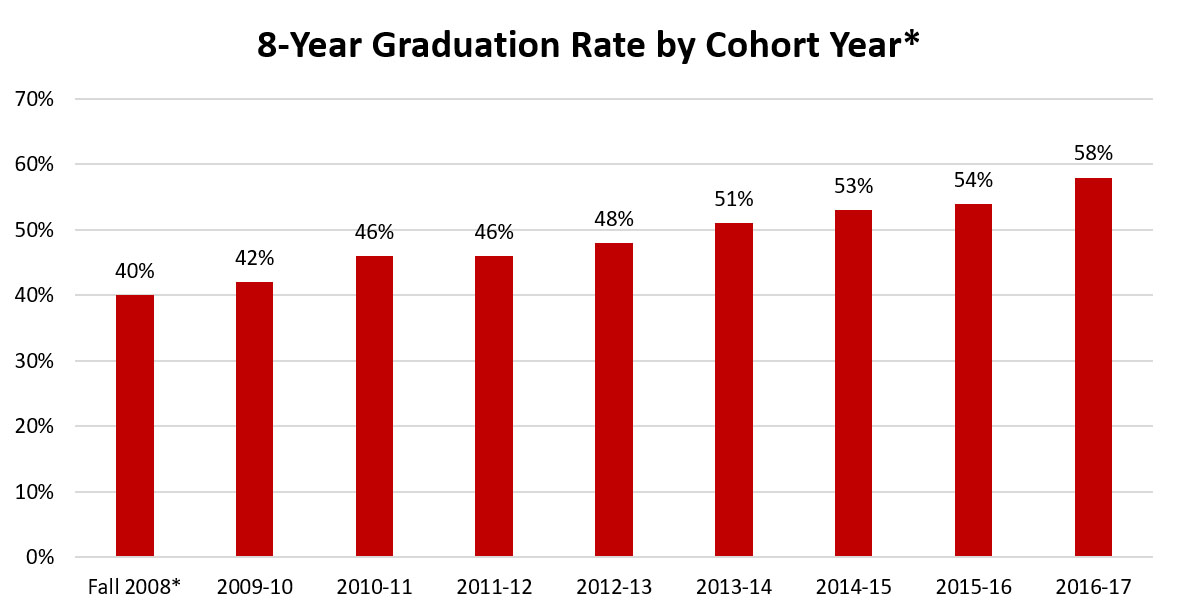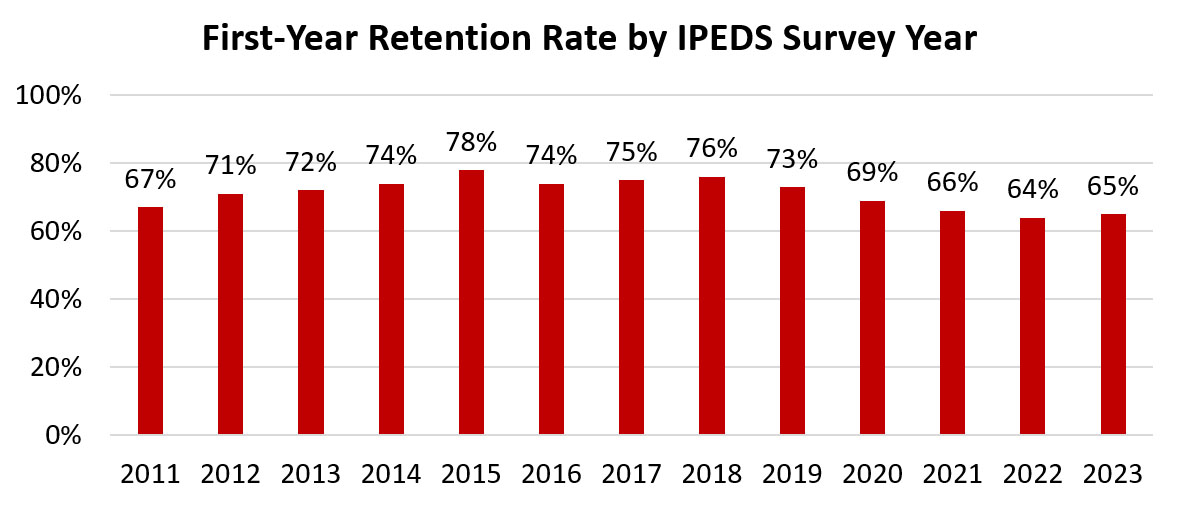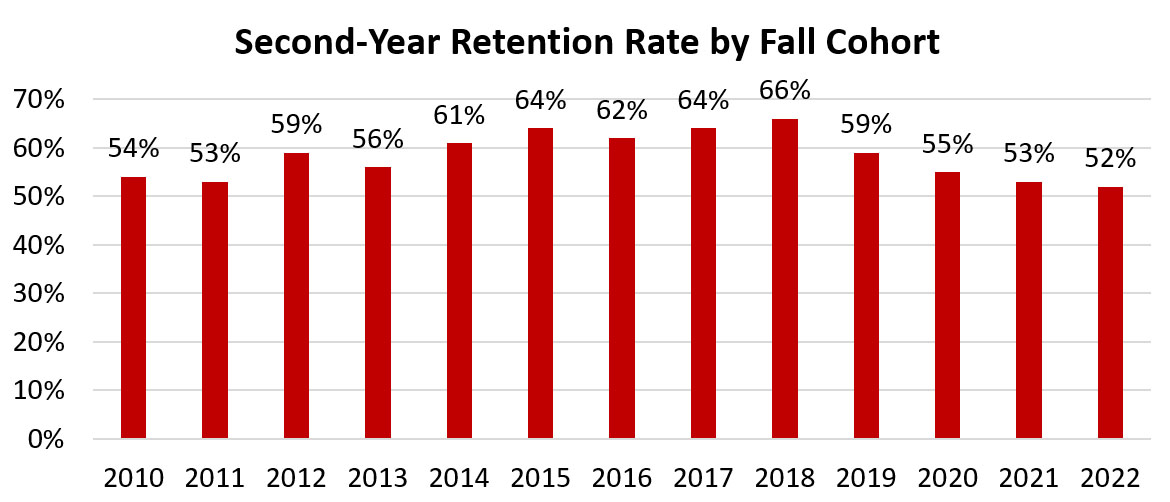Student Achievement

In accordance with the Southern Association of Colleges and Schools Commission on Colleges (SACSCOC) Standard 8.1, “The institution identifies, evaluates, and publishes goals and outcomes for student achievement appropriate to the institution’s mission…,” Jacksonville State University has identified student achievement metrics, provided appropriate data, established thresholds of acceptability, and explained how each criterion relates to its mission. The student achievement measures identified by the University are:
- Eight-Year Graduation Rate
- First Year Retention Rate
- Licensure and Certification Pass Rate
- Developmental Education
Consistent with the mission of Jacksonville State University (JSU), a learning-centered institution, the University identifies student achievement goals, presents and evaluates data related to those goals, and publishes relevant results on online through this webpage and other means. JSU increasingly relies upon student achievement data to benchmark and holistically enhance student success in all aspects of the college experience. Each institutional division shares in the responsibility of student success and works independently and collectively to that end.
Jacksonville State University's Student Achievement webpage is maintained by the Institutional Accreditation office and is updated each spring term in May when all data become available.
Graduation Rate: IPEDS 8-Year Outcomes
JSU selected the IPEDS 8-Year Outcomes as its completions indicator. This metric includes all first-time, full- and part-time freshmen and transfer students. Further, it represents a relatively standardized measure of JSU’s graduation rate at the undergraduate level as it is already measured and reported as required by IPEDS. JSU’s 8-Year Graduation Rate Target Performance Level is 56%.

*IPEDs Outcome Measures transitioned from a Fall only cohort during the 16-17 reporting year to a full-year cohort during the 17-18 reporting year and beyond
First- and Second-Year Retention Rate
The tables below show the first- and second-year retention rates of JSU first-time, full-time freshmen. The Target Rate for first year retention is 75%- and second-year retention is 65%.


Licensure & Certification Pass Rate
Students in the Teacher Education Program and in the Bachelor of Science in Nursing (BSN) Program must achieve initial licensure or certification in order to practice professionally upon graduation.
Teacher Education Program
In order to achieve initial certification in Alabama, prospective teachers must (a) earn a bachelor’s degree from an approved educator preparation program with a minimum Grade Point Average (GPA) of 2.75, (b) pass the Praxis Core Academic Skills for Educators Test (this requirement was discontinued by the Alabama State Board of Education effective August 13, 2020 and consequently by JSU at the same time), (c) pass the Praxis Subject Assessment, and (d) pass the national Teacher Performance Assessment (edTPA). Data for those students completing the teacher education program are presented in the tables below.
The target rate for each area are:
- Target Grade Point Average: 3.45
- Target Praxis Subject Assessment Pass Rate: 66%
- Target Teacher Performance Assessment Pass Rate: 95%
Grade Point Average
|
Year |
Minimum GPA |
Completers (n) |
GPA (Mean) |
|
2023-24 |
2.50 |
199 |
3.61 |
|
2022-23 |
2.50 |
243 |
3.63 |
|
2021-22 |
2.50 | 223 |
3.56 |
|
2020-21 |
2.75 |
214 |
3.67 |
|
2019-20 |
2.75 |
200 |
3.61 |
|
2018-19 |
2.75 |
171 |
3.54 |
|
2017-18 |
2.75 |
175 |
3.48 |
|
2016-17 |
2.75 |
164 |
3.43 |
|
2015-16 |
2.75 |
204 |
3.38 |
|
2014-15 |
2.5 |
146 |
3.41 |
Data Source: JSU Banner ARGOS Report JSH0023
Minimum GPA as required for unconditional admission to an undergraduate teacher education program and initial certification in Alabama
Praxis Subject Assessment Pass Rates
|
Year |
Number Taking Assessment1 |
Number Passing Assessment2 |
Institutional Pass Rate3 |
|
2023-24 |
258 |
226 |
87% |
|
2022-23 |
294 |
258 |
88% |
|
2021-22 |
274 |
230 |
84% |
|
2020-21 |
212 |
192 |
91% |
|
2019-20 |
203 |
200 |
99% |
|
2018-19 |
170 |
170 |
100% |
|
2017-18 |
168 |
166 |
99% |
|
2016-17 |
155 |
154 |
99% |
|
2015-16 |
206 |
203 |
99% |
|
2014-15 |
133 |
133 |
100% |
Data Source: ETS Title II Reporting Services – HEOA Summary Institution-Level Pass Rate for JSU Traditional (Undergraduate) Teacher Preparation Program Completers
Note: In cases where there are less than ten students taking the assessment, the number passing and pass rate are not reported.
1 Number of completers taking one or more assessments within their area of specialization.
2 Summary level “Number Taking Assessment” may differ from assessment level “Number Taking Assessment” because each student is counted once at the summary level but may be counted in multiple assessments at the assessment level.
3 Institutional Pass Rate – Includes test retakes within given time frame
edTPA Pass Rates
|
Year |
Number Taking Assessment1 |
Number Passing Assessment2 |
Institutional Pass Rate3 |
|
2023-24 |
261 |
257 |
99% |
|
2022-23 |
296 |
292 |
99% |
|
2021-22 |
271 |
271 |
100% |
|
2020-21 |
83 |
78 |
94% |
|
2019-20 |
203 |
200 |
99% |
|
2018-19 |
176 |
174 |
99% |
|
2017-18* |
97 |
93 |
96% |
|
2016-17 |
NA |
NA |
NA |
|
2015-16 |
NA |
NA |
NA |
|
2014-15 |
NA |
NA |
NA |
Data Source(s): Pearson edTPA edReports ResultsAnalyzer® (JSU Test Summary Reports and Pass Rate Analysis Reports)
Note: Effective September 1, 2018, edTPA became consequential for initial certification in Alabama.
1 Number Taking Assessment – Number of individual students taking assessment during reported time frame
2 Number Passing Assessment – Includes test retakes within reported time frame
3 Institutional Pass Rate – Includes test retakes within given time frame
Bachelor of Science in Nursing
To become a registered nurse, nursing students must pass the National Council Licensure Exam (NCLEX) administered by the National Council of State Boards of Nursing (NCSBN). The NCSBN has established 80% as the minimum passing score. JSU has established a pass rate of 90% as its target pass rate.
NCLEX Pass Rate
|
Year |
Pass Rate |
|
2024 |
91.41% |
|
2023 |
97.37% |
|
2022 |
92.70% |
|
2021 |
89.09% |
|
2020 |
87.84% |
|
2019* |
94.90% |
|
2017-2018 |
95.10% |
|
2016-2017 |
91.90% |
|
2015-2016 |
90.90% |
|
2014-2015 |
81.70% |
Math and English Developmental Education
All entering freshmen are required to take JSU’s online math placement test. Entering freshmen without an acceptable English ACT score are also required to take JSU's online English placement test. Some exemptions, such as prior credit in a non-developmental math or English class, may apply. Students with test scores below the threshold for non-developmental placement have two options. They can enroll in the appropriate developmental course or they can participate in a free, self-paced, online, personalized study plan called EdReady that allows them to independently assess their specific content-area weaknesses and work through instructional modules to improve their knowledge and understanding in those specific areas. Upon achieving a satisfactory EdReady score, the student may then enroll in the appropriate credit-bearing math or English course without having to take the developmental class.
Developmental Math EdReady Pass and MS 100 Completion Rates
JSU has established a math EdReady pass rate of 95% as its target pass rate.
|
Math EdReady |
MS 100 (Developmental Course) |
|||||
|
Year |
Enrolled (n) |
Completion (n) |
Completion (%) |
Enroll (n) |
Pass (n) |
Pass (%) |
|
2023-24 |
1424 |
1167 |
82 |
763 |
497 |
65 |
|
2022-23 |
1539 |
1353 |
88 |
688 |
424 |
62 |
|
2021-22 |
1764 |
1540 |
87 |
811 |
411 |
50 |
|
2020-21 |
1993 |
1415 |
71 |
559 |
199 |
35 |
|
2019-20 |
1764 |
1540 |
87 |
811 |
41 |
50 |
|
2018-19 |
1339 |
1181 |
88 |
169 |
63 |
37 |
|
2017-18 |
980 |
932 |
95 |
250 |
138 |
55 |
|
2016-17 |
1056 |
1008 |
95 |
383 |
244 |
64 |
|
2015-16 |
1248 |
1076 |
86 |
389 |
261 |
67 |
|
2014-15 |
NA |
NA |
NA |
324 |
191 |
59 |
Developmental English EdReady Pass and First-Year Writing Pathway Pass Rates*
JSU has established an English EdReady Pass rate of 70%. This will rate will likely be adjusted after more data is available. The English EdReady program, as it exists now, was piloted in Fall 2019.
|
|
English EdReady |
First Year Writing Pathway Pass Rate |
||||
|
Year |
Enrolled (n) |
Completion (n) |
Completion (%) |
Enrolled (n) |
Pass (n) |
Pass (%) |
|
2023-24 |
1130 |
982 |
87 |
TBD |
TBD |
TBD |
|
2022-23 |
986 |
896 |
91 |
604 |
341 |
56 |
|
2021-22 |
1651 |
1436 |
87 |
438 |
260 |
59 |
*In Fall 2021, the JSU English Department replaced EH 100 Basic English Skills with a new sequence of enhanced writing courses: EH 105 Enhanced English Composition I & EH 106 Enhanced English Composition II that require corequisite enrollment in EH 115 Writing Studio I & EH 116 Writing Studio II.
|
|
English EdReady |
EH 100 (Developmental Course) |
||||
|
Year |
Enrolled (n) |
Completion (n) |
Completion (%) |
Enrolled (n) |
Pass (n) |
Pass (%) |
|
2020-21 |
267 |
130 |
49 |
147 |
99 |
67.3* |
|
2019-20 |
348 |
162 |
47 |
156 |
125 |
80.1 |
|
2018-19 |
0 |
0 |
0 |
208 |
149 |
71.6 |
|
2017-18 |
0 |
0 |
0 |
215 |
141 |
65.6 |
|
2016-17 |
0 |
0 |
0 |
162 |
125 |
77.2 |
|
2015-16 |
0 |
0 |
0 |
296 |
191 |
64.5 |

